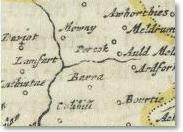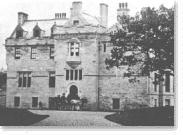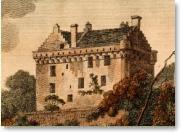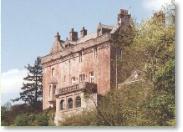 |
The Castle from Blaeu's Atlas
c.1654.
© National Library of Scotland |
|
|
 |
Sorn Castle, early 19th century.
|
|
|
 |
Painting of Sorn Castle, early18th
century.
|
|
|
 |
Sorn Castle, from the river, 2002.
| |
|
 |
| |
 |
A History of Sorn
Castle (credit for much of the
below history, and photo's of Sorn is due to Kenny Baird of http://www.ayrshirehistory.com)
Sorn is a Celtic word, meaning a promontory, or rising-ground of frowning
aspect. Sorn Castle undoubtedly received its name from its situation, as it
stands high on a precipitous rock overhanging the water of Ayr. Almost sheer
down from its massive walls, forty or fifty feet below their foundations, the
clear stream dashes and tumbles over its rocky bed. At the time when the castle
was built a site was eligible only as it showed advantages for purposes of defence. In such days the situation must have seemed an ideal one. From the side
facing the river, the castle was almost impregnable, and the undulating country
which stretched beyond could easily be overlooked from the castle walls. In
front, the bare, treeless expanse of those days would offer no hiding place from
watchful sentries. Such a stormy, troublous epoch has, happily, long since
passed away, and the castle has again and again been adapted to meet the wants
of the times, but in all its changes it has ever been the effort of its
restorers to conserve its strictly Scottish style of architecture. In that they
have been successful, and it is now a stately pile, with turreted windows, or
low, broad casements, the crest of the Somervell family carved in high relief
beside the entrance hall, the new part and the old blending into each other
without the slightest incongruity. Its situation, chosen at first undoubtedly
for defence, is now considered admirable because of its beauty. At an elbow-like
turn in the river, near the kirk of Sorn, the bank on one side rises from almost
canal-like flatness to steep bluffs and perpendicular scars of rock. And high on
its rocky promontory above the clear, impetuous stream, where its waters are
caught and deepened and silenced in a long, slanting weir, stands this castle of Sorn.
Of reddish stone, with windows set far back, like eyes deep-sunk with age, it is
outlined through intervening trees or seen above their swaying branches.
The lands of Sorn belonged originally to the Keiths of Galston. Janet de
Keith, heiress of Galston, married, first, Sir David de Hamyltoune of Cadzow,
ancestor of the ducal house of Hamilton, and, secondly, Sir Alexander Stewart of
Darneley. To her son of the first marriage, Andrew de Hamyltoune, she granted
the lands of Sorn among others, and the charter was confirmed under the great
seal on the 11th December, 1406. Whether the castle was built before that time
or no does not appear, but the likelihood is that its erection was of an earlier
date. Its first form was that of a keep, and there is a tradition to the effect
that the masons employed in building it had the option for their wages of l.5 d
per day or a peck of meal. If not built before Andrew de Hamyltoune's time, it
must have been built when he acquired the land, for it became his residence.
The
proprietors of Sorn Castle and descendants of Andrew de Hamyltoune have been
among the most illustrious families in the kingdom. Andrew Hamilton married Agnes, a daughter of Sir Hugh Campbell of Loudoun,
Sheriff of Ayr, and by her had a son, Sir Robert Hamilton of Sorn and Sanquhar.
Sir Robert married a daughter of Sir William Crawford of Lorhnorris; and Sir
William Hamilton of Sorn and Sanquhar, a son of this marriage, was one of the
Senators of the College of Justice and Lord Treasurer to King James V, as well
as Captain of Edinburgh Castle. He married a Kennedy daughter of the family of Cassilis, by whom he had an
heiress, Isobel Hamilton, who married George, 7th Lord Seton.
James V visited Sorn Castle by invitation of George, 6th Lord Seton on the occasion of
his son's marriage to the heiress Lady Isobel Hamilton, and which marriage
brought Sorn to that family. The chair which His Majesty is said to have used on the
occasion was kept in Sorn Castle till the sale of the estate in 1782, when it
was transferred to Loudoun Castle, where it still remains. It is a large chair
of oak, of curious workmanship, with the arms of Sir William Hamilton carved
upon the back.
The story of the King as he travelled to Sorn is:
The journey was
undertaken in the winter, and in those old days travelling was
quite a different matter from what it is now. The King was heartily tired of his
ride over moor and moss and clay, and said "if he could play the Devil a trick
he would send him from Glasgow to Sorn in the depths of winter." A well about
half-way from Glasgow, from which His Majesty drank, is called the King's Well
to this day. The horse upon which the King rode came to grief
near the well. It sank in the bog, and His Majesty was rescued with some little
difficulty. The King made a joke of it, and said that his horse was truly stabled, and
even now, or until a few years ago, the spot was known as the King's Stable.
Yet the marriage of the Isobel was a very important one
also, and Sir Richard Maitland in his "Historie of the House of Setoune," says
that "the union was devised to bring about an alliance betwixt the Setounes and
the Governor Arran, to whose house Sir William belonged, and was of such
political importance that a medal commemorating it was struck, bearing the
initials of the bride and bridegroom, I. H. and G. S., and the motto, "ung loy,
ung foy, ung roy," is of great historical interest, as an example of ancient phonetic spelling of French!
George 7th Lord Seton and Isobel Hamilton were parents to
Robert, 8th Lord Seton who became a great favourite
of James VI and was created by him 1st Earl of Winton, by a charter dated 16th Nov 1600; to Alexander,
1st Earl of Dunfermline and Chancellor of Scotland under James VI; to Sir John
of Barnes; to Sir William of Kyllismuir, and to Margaret who's marriage was
celebrated at Lord Seton's castle of Niddry to Claud Hamilton, Lord Paisley,
ancestor to the Earl of Abercorn.
The lands and castle of Sorn were sold by the succeeding Robert Seton, 2nd Earl of
Winton to the family of Loudoun, and after remaining in that family for upwards
of a hundred and fifty years they were sold to William Tennent, Esq., of Poole,
in 1782."
Mr. Tennent retained possession of the castle and lands for only a few
years and Mr. Graham of Limekilns, and Mr. Stevenson of Dalgain, became the next
proprietors. In 1795 Mr. Somervell of Hamilton Farm, who was a partner in the
house of Somervell, Gordon & Co., long known as one of the most eminent
mercantile families connected with our colonies, bought the lands and castle and
they remain in the Somervell family to this day.
Charles II. seized Sorn Castle, among others, about the year 1665, by virtue
of an obsolete Act, and garrisoned it with dragoons for the purpose of overawing
the Presbyterians in that quarter. Among the family papers of Auchmannoch is the
following relic of those eventful times :
"God save the King."
"I, Lewis Lauder, Governor of Sorn Castle, dow heirby certifie and declare,
vlz.-Klrkwood, servitor to Arthur Campbell of Auch-mannoch, in the parish of
Sorne, did compeir before me, on solemn oath before Almightie God, did abjure
and renounce the late traitorous apologeticall declaration, in so far as it
declares war against his majestie, and asserts that it is lawful to kill all
such as serve his majestie in church, state, armie, or countrie, conform to his
majestie's late proclamation of the 30th Daye of December last.-Given at Sorn,
the aught day of February, 1688 zeirs.
"LEWIS LAUDER."
The troop of dragoons quartered at Sorn killed at least two lads in
high-handed fashion, one at Tinkhornhill, and another, at the instigation of the
curate of Sorn, at Tarbolton; many a conventicle was scattered at their
approach, and the moors and moss hags in the neighbouring parish of Muirkirk are
dotted with memorials of martyrs of the Covenant. What tyranny they exercised
over the poor people we can well imagine. Their power was unlimited, and they
were not the men, as those murders testify, to fall short in its use. The prayer
which heads the written oath "God save the King " was the watchword of the day.
If a suspect repeated the words he was allowed
to go; if not, so much the worse for him. We read of brave men and women who
refused this watchword or test, not, surely, because they wished other than good
to their sovereign, but to utter those words implied that they gave their
adherence to the King and to all his decrees, and swore the whole of the test
oath. Adherence to their sovereign was their duty, but when a King calmly
declared himself arbiter of a nation's conscience, it was altogether another
matter.
A large, beautiful flag of white silk is carefully preserved in the castle of
Sorn- somewhat frayed now and discoloured with age. It was carried by the
Covenanters at Drumclog, and again in procession when William III. was declared
King. It bears the motto
"For God and the Presbyterian Reformation, for crown and country " - a crown,
the letters W.R., and the date 1689. The lettering is in gold, the crown in blue
and gold. The crown, initials, and date must have been added at a slightly later
period than the motto, which in all probability was all it bore at first. With
William and Mary dawned a brighter day for the Church of Scotland. Sixty years
ago, the flag was showing signs of the decay of age. The silk had rotted so much
that there was a danger of losing it altogether. The Curlers' Club had it
repaired very carefully with a backing of new silk, and inscribed that fact upon
it. It now reposes in state in Sorn Castle, in a mahogany chest, in a quaint old
cupboard of the library.
About the beginning of the eighteenth century, Hugh, first Earl of Loudoun,
married a daughter of John, first Earl of Stair. The lands of Sorn belonged to
the Earl of Loudoun, and in the year 1727 the Countess took up her residence at
Sorn Castle. She came to Sorn as the Dowager-Countess, and lived there for the
long period of fifty years. When she died she was within a few months of
completing her hundredth year. In those days servants clung to the service of
one family, and seemed almost as much a part of the household as the sons and
daughters. Most of the servants that the Countess brought with her remained
during her life in her service, and some of them attained nearly as great an age
as their mistress.
The Countess was very beautiful as a young woman, and with
greater age, although the freshness of youth must have gone, she did not lose
her charm, and through all her long life-time was ever a sprightly, handsome,
and dignified gentlewoman. When she came to Sorn her health gave her friends
some cause for alarm, but she speedily recovered tone in the pure bracing air,
and was almost untroubled by sickness again until a few days before her death.
Besides being beautiful the Countess was a most cultured woman for her time, and
she acquired a "large portion of those mental and liberal accomplishments which
so much adorned the brilliant courts of Queen Anne and George I., and possessed
moreover in a high degree that dignity of character and deportment, and that
vigorous and active spirit, by which her brother, the celebrated Ambassador, was
so eminently distinguished."
When the Countess of Loudoun came to Sorn, instead of the beautiful grounds
laid out in the highest style of art which now surround the castle, and the
lovely winding walks, shadowed by great trees along the banks of the Ayr, and a
highly-cultivated tract of country stretching on every side with hedges and
trees and plantations, the Countess found a bare, dreary expanse, with not a
single road or hedge and very few trees. The castle was built around a courtyard
at that time, and had all the characteristics of a fortress or keep. Her
chronicler quaintly says that the Countess was not discouraged although she came
from "a better country." She immediately set about working a great reformation
in her surroundings.
She found only a very small garden and orchard; those she
enlarged considerably and improved. She took an extensive farm into her own
hands, enclosed the fields in hedges and interspersed them with belts and clumps
of planting. She also adorned the banks of the river with trees and walks and
the banks also of tributary rivulets. Scenes of beauty sprang up around her, to
her great enjoyment. Many of the trees were planted and pruned by her own hands,
and some of them remain to this day-giants of the woodland. The reformation the
Countess initiated in agricultural matters was gradually followed by neighbouring proprietors. Mr. Steel, Mr. Farquhar of Gilmilnscroft, and Mr.
Dunlop of Garnkirk took up the matter enthusiastically and the centre of the
parish soon displayed a wonderful improvement.
Roads were made, hedges planted, drystone dykes erected, growing of trees was much encouraged, and reclaiming of
moorland was gone into with great zest. The Countess died on the third of April,
1777. She had been a most liberal benefactor of the industrious poor, a most
faithful steward of her goods, a gentlewoman of the old school, a happy, clever,
sprightly personality. When she died, her passing left a blank, which to her
many friends could not be filled.
The ancient keep, in the Countess's old age, must have sheltered a striking
household. The castle itself accorded well with its inhabitants- brown with age
as it was, old-fashioned, with stories of other days haunting every nook and
corner; grey-haired retainers in the servants' hall, an ancient waiting-woman
keeping watch and ward over her still more ancient mistress, whose spirit was as
young as her body was frail and old! Twenty years after the Countess died, four
of her servants were still living- one who had become the church officer and was
at that time eighty-five years of age; a gardener and his wife, both
ninety-four, who had been married sixty-eight years; and the possessor of a
small farm, who was ninety-six. The last was the most vigorous of all, and made
a point of walking several miles every day.
Mr. Tennent, the next proprietor, repaired the castle in a most thorough
manner and built large additions to it. Among the additions was a most
magnificent drawing-room, and a very handsome staircase. The castle was
described by a writer of the time as a most spacious, commodious, and
comfortable mansion.
In the year 1837, while a walk was being formed along the side of the Cleugh,
some workmen came upon a wonderful treasure-trove. It was no less than five
hundred coins of copper and silver, some of them dating so far back as the
fourteenth century-the reign of Robert III. There were also representative coins
of the reign of each James. It was supposed that they had been hidden by the
Covenanters in the days of the Persecution. Perhaps the exact spot where they
were hidden was forgotten, and some expectant soul may have toiled and dug many
places in vain for his hidden treasure, or death may have come suddenly and
snatched away their owner without giving him time to confide the secret of the
hiding-place to another.
They may have been stolen and hidden there, but it seems more likely that it
was a treasure hidden for safety. The denomination of the coins is pathetically
small, even for the great value of money of the times, like a long, well
gathered hoard. The silver coins are very little- some of them round, others
octagonal, with edges as if clipped. Such a find naturally was noised abroad,
and although the workmen delivered the coins to Mr. Somervell, he was not
allowed to keep them. The Government claimed them, and they were sent off. About
fifty were returned from the Exchequer, and are kept as antiquarian curiosities
in the castle.
The last time that the castle was repaired or restored was
upwards of thirty years ago, when Mr. Somervell again added to it and very
considerably improved it. It is of the pure Scottish type of architecture, and
has not suffered from the many heads and hands that have planned and worked at
it, for it has been the endeavour of each succeeding restorer to retain its
characteristic style. It is a handsome building in every way, and a commodious
and beautiful residence. In the Island of Westray there is a ruined castle of
massive Scottish architecture to which the castle of Sorn bears a striking
resemblance. But while the castle of Westray has become a ruin, the castle of
Sorn has had a happier history, in that it has been carefully preserved, and
century after century has been the home of noble and patriotic Scottish men and
women.
| |
 |

